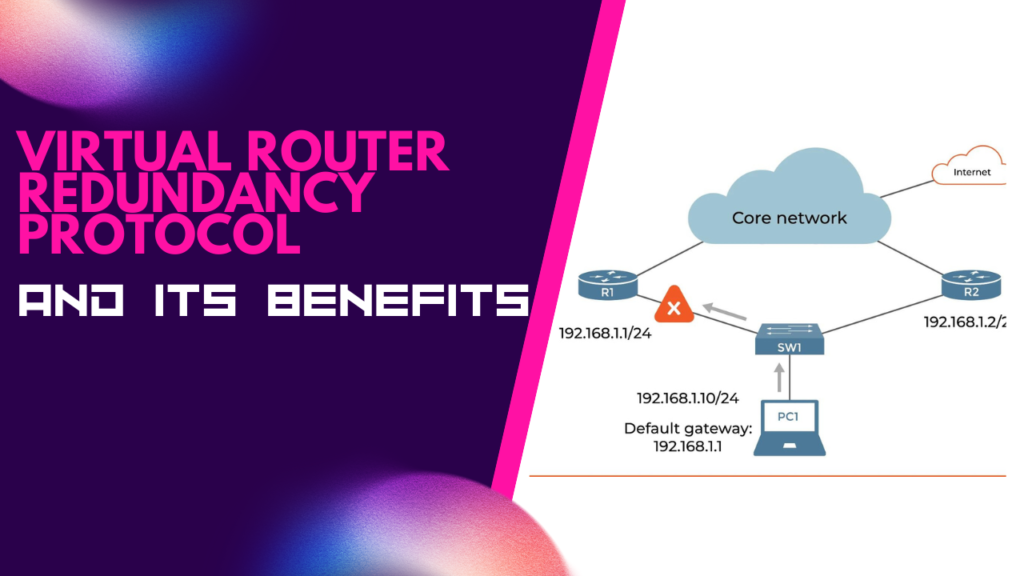Introduction to VRRP
In today’s digital age, network resilience is crucial for businesses to maintain uninterrupted connectivity and optimal performance. One technology that plays a vital role in achieving this resilience is the Virtual Router Redundancy Protocol (VRRP). VRRP is a network protocol that allows multiple routers to work together seamlessly, providing redundancy and failover capabilities in case of any router failure. In this article, we will delve into the details of VRRP, its functionality, benefits, and implementation so you can ensure a robust and resilient network infrastructure for your organization.
Understanding the importance of network resilience
Network resilience is a critical aspect that organizations should prioritize in today’s fast-paced and interconnected world. The ability to maintain uninterrupted connectivity and optimal performance is essential for businesses to stay competitive and meet customer demands.
Network failures or downtime can result in significant financial losses and damage the reputation of an organization. With the increasing reliance on digital communication and data transfer, the need for a resilient network infrastructure has become more crucial than ever before.
VRRP, also known as the Virtual Router Redundancy Protocol, is a technology that can significantly enhance network resilience. By allowing multiple routers to work together seamlessly, VRRP provides redundancy and failover capabilities, ensuring uninterrupted connectivity even in the event of a router failure.
In the next section, we will dive deeper into the importance of network resilience and how VRRP can help organizations achieve it. Stay tuned!
What is VRRP, and how does it work?
VRRP, or Virtual Router Redundancy Protocol, is a networking protocol that allows multiple routers to act as a single virtual router. This creates a redundant and highly available network infrastructure, ensuring seamless failover in the event of a router failure.
At its core, VRRP works by electing a virtual router master, which is responsible for forwarding packets on behalf of the group. The other routers in the group act as backups and monitor the master router’s status. If the master router fails, one of the backups will take over its responsibilities, maintaining uninterrupted connectivity.
VRRP achieves this failover capability by utilizing a virtual IP address shared among the routers in the group. This virtual IP address serves as the gateway for hosts on the network, allowing for transparent failover without the need for reconfiguration.
In the following sections, we will explore the benefits of implementing VRRP in your network infrastructure and discuss its key features and considerations. Stay tuned to learn more about how VRRP can enhance network resilience.
Benefits of implementing VRRP in your network
Implementing VRRP in your network infrastructure comes with numerous benefits that can greatly enhance your network’s resilience and availability. Here are some of the key advantages of using VRRP:
1. Improved network uptime:
By creating a redundant and highly available network infrastructure, VRRP ensures that even if a router fails, the network remains operational with minimal downtime. This is especially critical for businesses that rely heavily on continuous connectivity.
2. Seamless failover:
VRRP allows for seamless failover in the event of a router failure. The backup routers automatically detect the failure of the master router and take over its responsibilities, maintaining uninterrupted network connectivity for the devices on the network.
3. Load balancing:
By distributing network traffic across multiple routers, VRRP enables load balancing, optimizing the utilization of network resources. This helps prevent congestion on individual routers and promotes efficient data transfer.
4. Simplified network management:
Using VRRP, you can easily manage multiple routers as a single virtual entity. This simplifies network management tasks, such as configuration changes, firmware updates, and security implementations.
5. Scalability:
VRRP allows for the addition of more routers to the network without disrupting its operation. This makes it easy to scale your network infrastructure as your business grows.
In the next section, we will delve into the key features and considerations to keep in mind when implementing VRRP in your network. Stay tuned to further explore the power of VRRP in enhancing network resilience.
Common misconceptions about VRRP
While VRRP offers several advantages in terms of network resilience and availability, some common things need to be clarified about its implementation. It is important to address these misconceptions to ensure a proper understanding of VRRP’s capabilities. Let us debunk a few of them:
1. VRRP is only suitable for large enterprise networks: This is not true. VRRP can be implemented in networks of all sizes, from small businesses to large enterprises. It provides network redundancy and failover capabilities that are beneficial for any organization.
2. VRRP is complex and difficult to configure: While VRRP does require initial configuration, it is relatively easy to set up using the appropriate networking equipment. Once configured, it runs seamlessly in the background without requiring constant management.
3. VRRP causes performance degradation: When properly implemented, VRRP should not cause any significant performance degradation. The load balancing feature actually enhances the utilization of network resources and prevents congestion.
By addressing these common misconceptions, we hope to provide a clearer understanding of VRRP and its benefits. In the next section, we will explore best practices for implementing VRRP and optimizing its performance. Stay tuned!
Implementing VRRP in your network: Step-by-step guide
Now that we have debunked some common misconceptions surrounding VRRP, let us dive into how you can implement this protocol in your network. Follow these step-by-step instructions to ensure a seamless integration:
Step 1: Assess your network requirements
Before implementing VRRP, it is important to assess your network’s specific needs. Consider factors such as the number of routers, network traffic patterns, and criticality of network services. This will help you determine the appropriate number of VRRP instances and prioritize configuration settings.
Step 2: Select VRRP-capable networking equipment
Ensure that your networking equipment supports VRRP. Check the manufacturer’s documentation or consult with your network administrator to verify compatibility. Having the right hardware is crucial for successful implementation.
Step 3: Configure VRRP on your routers
Using the manufacturer’s guidelines, configure VRRP on your routers. This involves assigning a virtual IP address and priority levels to each router. Make sure to select a master router that will assume the responsibility of forwarding traffic in case of an outage.
Step 4: Test and monitor your VRRP implementation
After configuring VRRP, thoroughly test and monitor your implementation. This includes simulating network failures, verifying failover capabilities, and monitoring performance to ensure optimal functioning.
Step 5: Document your VRRP configuration
Once your VRRP implementation is complete and stable, document the configuration details for future reference. This will prove helpful during troubleshooting or when scaling your network infrastructure.
By following these steps, you can confidently implement VRRP in your network, ensuring seamless network resilience and availability. In the following section, we will discuss how to optimize VRRP performance and address any possible challenges that may arise. Stay tuned for more!
Best practices for VRRP configuration and management
While implementing VRRP is a great step towards achieving network resilience, certain best practices can further optimize its performance. Here are some tips to consider during VRRP configuration and management:
1. Use unique VRID values: Each VRRP instance should have a unique Virtual Router Identifier (VRID) value. This ensures proper identification and prevents conflicts within the network.
2. Configure preempt options: Enabling the preempt option allows the master router to regain its status after recovering from an outage. This ensures a smooth transition and eliminates any unnecessary failovers.
3. Implement authentication: Adding an authentication mechanism, such as using a shared secret key, enhances the security of the VRRP network. This prevents unauthorized routers from participating in the VRRP election process.
4. Regularly monitor VRRP status: Continuously monitoring the VRRP status helps identify any potential issues or misconfigurations. Using network monitoring tools, keep a close eye on the VRRP state and take prompt action in case of any abnormalities.
5. Regularly update firmware: Keep your networking equipment’s firmware up to date to ensure compatibility with the latest VRRP features and bug fixes. Check the manufacturer’s website regularly for updates and apply them as recommended.
By following these best practices, you can ensure a robust and efficient VRRP implementation in your network. In the next section, we will explore common challenges that may arise when using VRRP and strategies to overcome them. Stay tuned for valuable insights on troubleshooting and optimizing VRRP performance!
Troubleshooting common issues with VRRP
Despite its benefits, VRRP can encounter certain challenges that can affect network resilience. In this section, we will discuss some common issues that may arise when using VRRP and provide strategies to overcome them.
One common problem is the occurrence of VRRP flapping, where the master and backup routers frequently switch roles due to network instability. This can disrupt network connectivity and cause service degradation. To address this, ensure that your network has stable physical and logical connections, such as reliable cables and properly configured VLANs.
Another issue is the potential for configuration errors, which can lead to VRRP not functioning as intended. Incorrect settings, such as VRID mismatches or missing authentication keys, can result in routers not participating in the election process or unauthorized routers joining the VRRP group. Regularly review and validate your VRRP configurations to avoid such errors.
Furthermore, VRRP interoperability issues can arise when different vendors’ equipment is used. Incompatibilities in implementation can affect the failover process or lead to inconsistent behaviour. To mitigate this, ensure that the networking equipment used conforms to VRRP standards and is updated with the latest firmware.
In the next section, we will provide troubleshooting strategies for each of these common issues to help you maintain a stable and resilient network with VRRP. Stay tuned for valuable insights on addressing these challenges effectively!
VRRP vs other redundancy protocols: A comparison
In addition to addressing common challenges faced with VRRP, it is important to compare it with other redundancy protocols available in the market. This will enable you to make an informed decision based on your network requirements and the specific needs of your organization.
One of the widely used redundancy protocols is HSRP (Hot Standby Router Protocol). HSRP also provides network resilience by ensuring seamless failover between routers. However, there are some key differences between VRRP and HSRP that you need to be aware of.
HSRP is a Cisco proprietary protocol, whereas VRRP is an open standard, meaning it can be implemented on a variety of networking equipment from different vendors. As such, VRRP offers more flexibility and interoperability.
Furthermore, VRRP supports more routers in a group compared to HSRP, allowing for greater scalability. Additionally, VRRP is capable of load balancing and distributing traffic across multiple routers, whereas HSRP primarily focuses on providing redundancy.
It is crucial to carefully consider these differences when selecting a redundancy protocol for your network. In the next section, we will delve deeper into the comparison between VRRP and other commonly used redundancy protocols. Stay tuned for an in-depth analysis that will assist you in making the right choice for your network.
Conclusion: Boosting your network reliability with VRRP
In this final section, we will discuss the key takeaways from our exploration of VRRP and other redundancy protocols and how implementing VRRP can enhance the reliability of your network.
By now, you have gained a thorough understanding of VRRP and its advantages over other protocols like HSRP. VRRP’s open standard nature allows for interoperability and flexibility, making it adaptable to various networking equipment from different vendors. Its scalability and load-balancing capabilities further solidify its position as a robust redundancy solution.
Implementing VRRP in your network ensures seamless failover between routers, minimizing downtime and providing uninterrupted connectivity. This is achieved through the election of a virtual router that acts as the default gateway, eliminating single points of failure.
In conclusion, by leveraging VRRP, you can boost your network’s resilience and minimize the risk of network disruptions. As you evaluate your network requirements and organizational needs, consider implementing VRRP to enhance your network’s reliability and ensure seamless network operations.



